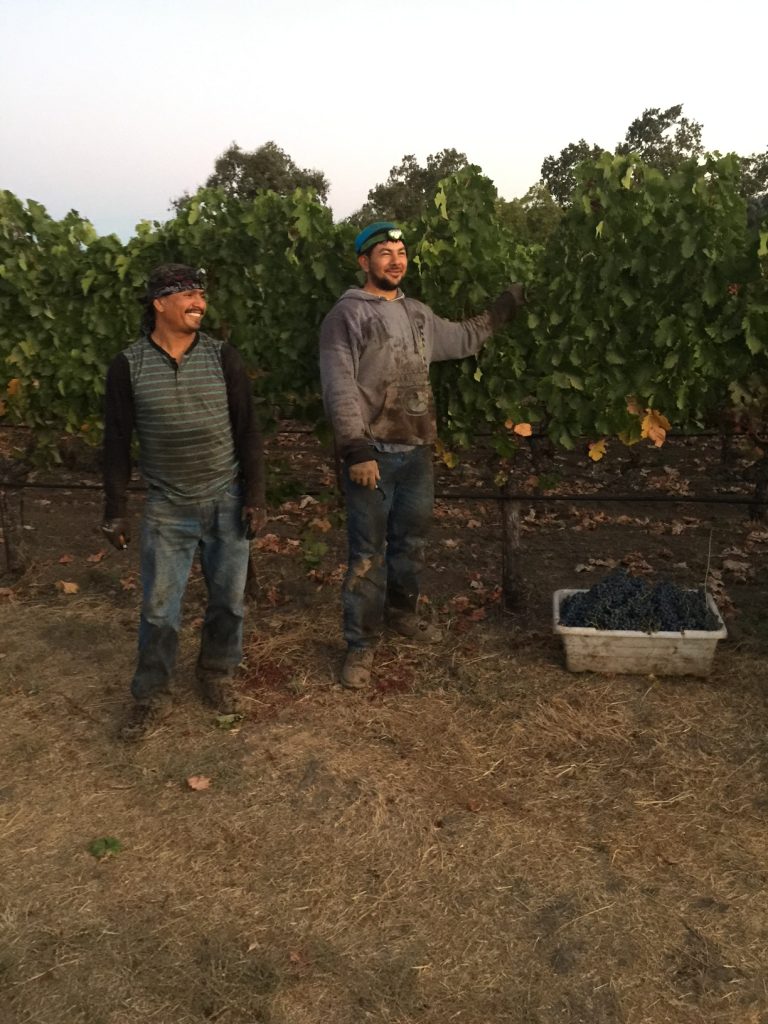WineInk: Harvest Season
The Hard Working People
WineInk

Kelly J. Hayes/Courtesy photo
Isn’t it ironic? Don’t-cha’ think? To borrow a phrase from Alanis Morrisette, “Yes, I really do think!”
In what is purported to be the warmest year on planet Earth since they started recording such things, the California wine grape harvest came late. Three weeks or more late in most cases due to the cool temperatures that prevailed in the spring and early summer months.
You remember our spring here in Aspen, right? Cold and overcast? Well, the coast got pretty much the same thing.
Whereas the pick in recent years began early in August amid burning near triple-digit heat, the 2023 harvest is still just getting started. Winemaker Pauline Lhote of Chandon California announced that late in the evening of Aug. 24 her team brought in nine tons of Pinot Meunier and 12 tons of Pinot Noir for the sparkling wines that Chandon specializes in. That was three weeks later than has been normal.
Each day since that initial pick, the vineyards of Napa have seen an uptick of activity, as different varieties of grapes reach ripeness and winemakers alert their teams of pickers that the time is nearly right to drop the clusters from the vines and get them into wineries.
While the wine grapes used in the production of sparkling wines, Chardonnay, Pinot Meunier, and Pinot Noir, are picked first, other red wine varietals for still wines are slower to ripen and many won’t be ready to be picked until late September if not into early October. The thinner-skinned, earlier ripening grapes like Merlot, Zinfandel, Syrah, and Sangiovese are all picked before the major harvest of Cabernet Sauvignon, the signature grape of the valley. And the Cab looks like there may still be some on the vine come Halloween.

In some cases, the trip for the harvested grapes is short, as they hail from vineyards literally adjacent to the production facilities. But for many vineyards, there is a rush to get grapes into trucks, so they can quickly be transported, while they are still cool, to the wineries that have contracted to buy them. Traffic builds early as the trucks make their trips.
The pre-dawn hours on the country roads remind me of the chorus of the Bruce Springsteen song “The Ghost of Tom Joad” that screams, “Well, the highways are alive tonight. Where it’s headed everybody knows.” It is an early morning visual of the harvest.
It is now a WineInk cliché (Of course, one man’s cliché is another’s tradition), but most years over the past decades, this column has made reference to the Rolling Stones’ song “Salt of the Earth.” That is because each year at this time, each harvest season, I think about those who toil to get the grapes off the vines. Those who rise in the middle of the night when their cell phones vibrate and head into the vineyards to pick the fruit at the precise moment when it will make the best wine for our enjoyment.
It’s hard work, picking grapes. A few years back, I went to Napa for a harvest morning to get a feel for what it takes to bring in a ton of Cabernet grapes. My September morning began in the chill of a 4 a.m. drive to the vineyard up Hwy 29, the main artery through the Napa Valley. This is pretty standard, as the best time to pick grapes is before dawn to avoid the heat of the day. But still, it means a 3:30 a.m. wake-up call and working in the dark.
The team I was with was like many in the Napa Valley. There were eight Latino workers altogether. Some worked full-time for the winery while others moved from one vineyard to another, working contract work whenever they could find a job during the harvest season. They are contracted to pick and make themselves available at the behest of the winemaker when the pick is called.
I remember watching in awe in the pre-dawn darkness, as the bright lights illuminated the vineyard and the team of pickers moved with alacrity up and down the rows of vines. With incredible dexterity, they cut the clusters of grapes from the canes with sharply curved knives in rapid-fire motion, so that the bunches dropped cleanly into the plastic bins at their feet. The men, paired in groups of two, worked on alternate rows as a tractor moved down the middle between them. There was lots of good-natured chatter, and the team occasionally broke into song as they moved rapidly down lines of vines.

Once each bin was filled with 35 to 50 pounds of grape clusters, the men lifted them high on their shoulders and dumped them into the trailer that trailed the tractor. As the first group made their deposit, the second group of two scurried ahead and began to cut more clusters. It was clear that there was order and a strategy to the process.
As I tried to keep up, I kept stumbling on the residue of vines that had fallen in my path. I did not cut myself with my cleaver, but it was only because I moved so slowly as to make sure that I would not do so. By the time I cut the clusters from the first vines, the team had already moved to the next row, laughing and speaking (I am sure about me) in Spanish. With a row completed, I raced to the tractor only to drop about a third of my bin on the ground. More laughter ensued. And by the end of about three rows, my hands and back were so sore that I was both hobbled and humbled.
The point is that this is what it takes to hand-pick grapes for premium wines. A lot of precise, elegant, and hard work. It is as much a skill as that possessed by any farm worker and one that is greatly admired by those winemakers who employ the teams who make the harvest happen.
And it is not just in the Napa Valley where this takes place. At this exact moment, there are workers toiling in France, Italy, Germany, China, and anywhere in the Northern Hemisphere where fine wine is made. These workers are frequently people of color. Immigrants who come for work and to make some money. Over time, some find full-time employment in the wine industry, but those are the lucky ones. For most, it is to line up and do as you are told.
So it is that each year, I try to write a column that pays homage to these oft-forgotten workers who are literally the backbone of the wine industry. They don’t make the wine, but without them, there would be no wine made.
So once again, let’s think about some of the lyrics in the Stones’ song, “Salt of the Earth.”
Let’s drink to the hard-working people
Raise your glass to the good and the evil
Say a prayer for the common foot soldier
Spare a thought for his back-breaking work
Say a prayer for his wife and his children
Let’s drink to the salt of the earth.
Cheers.
Klinker Brick Winery 2019 “Old Vine Zinfandel” Lodi
Lodi, in Central California is also experiencing a late harvest. I was looking for something with a bit of heft to go with pepperoni and mushroom pizza from New York Pizza when I stumbled upon this old friend. Klinker Brick is a family-owned winery that produces Zinfandel wines with power substance and balance from vineyards that were planted by generations past. This wine was from a cool-ish vintage in 2019 that allowed the Felten Family, makers of the wine, to leave the clusters on the vine a little longer, “coaxing out the rich fruit flavors without losing acidity.”
The ancient vines, some from blocks planted a century ago, produced a dense, fruit-driven wine that popped with the pepperoni. Mission accomplished.









